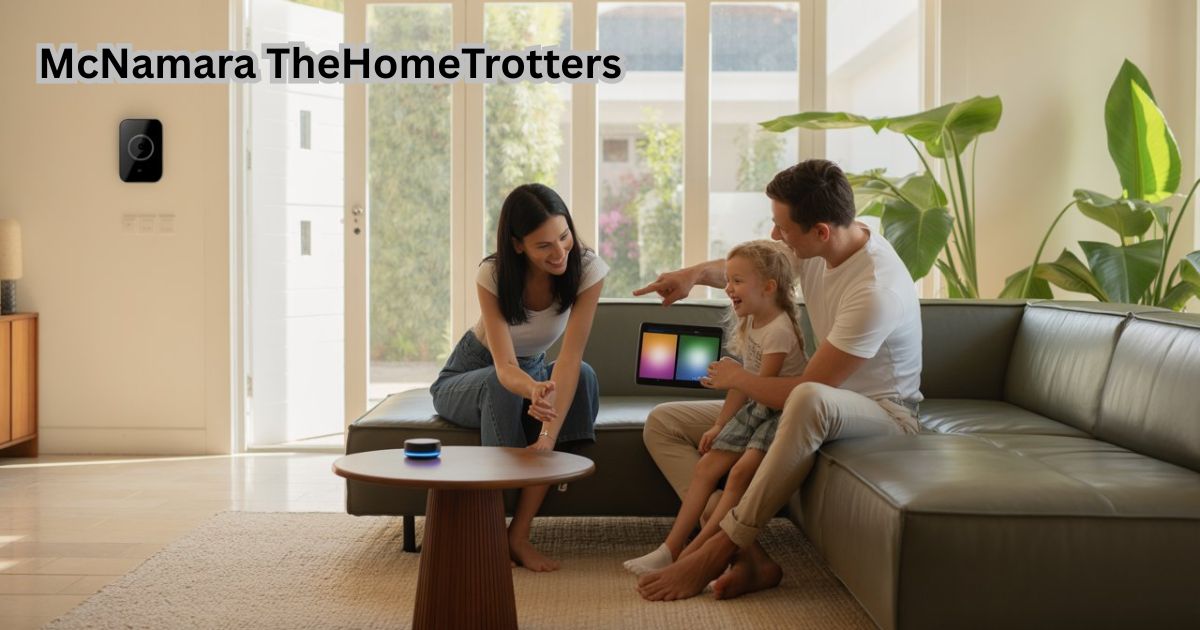McNamara TheHomeTrotters stands at the forefront of the smart home technology movement, offering insight and innovation to everyday homeowners. The brand combines decades of experience with a passion for modern, connected living. As people grow more interested in smart devices, automation, and security, McNamara TheHomeTrotters serves as a trusted voice for understanding and adopting these systems. Whether you’re upgrading for energy efficiency, enhancing home security, or aiming for full automation, this guide supports readers through the evolving world of intelligent living.
You May Also Like: Stalekracker Net Worth 2025: Career, Wife & Income Sources
The Rise of Smart Home Technology
Over the last decade, the adoption of smart home technology has significantly transformed how homes operate. From voice-activated lights to automated climate control, intelligent systems now power convenience in daily routines. Homeowners are increasingly drawn to technologies that improve comfort, security, and energy savings.
These systems work through Internet of Things (IoT) integration, creating a connected ecosystem where devices communicate and respond without manual input. As prices fall and user-friendliness rises, more families explore smart home upgrades through platforms like McNamara TheHomeTrotters.
What Makes a Home Smart?
A smart home uses connected devices and systems that are remotely monitored and managed. These include smart lights, thermostats, and security systems, which interact through central hubs or apps. The benefit lies in automation and personalization.
Popular Smart Devices in Modern Homes
Today’s market offers a wide array of smart devices designed to make living easier and safer. Devices like digital thermostats, smart locks, and smart lighting systems have become staples in many households. They offer users control and feedback in real time.
Users can monitor energy usage, secure their home from afar, and receive alerts for maintenance or safety breaches. McNamara TheHomeTrotters provides practical advice for choosing the right connected solutions.
Smart Thermostats
Smart thermostats, like Nest or Ecobee, learn user preferences over time. They optimize energy usage and increase comfort through programmable schedules and AI-powered decisions.
Smart Lights
Smart lighting, such as Philips Hue or LIFX, allows remote or scheduled control of home lighting. These lights adjust in brightness and color, enhancing both energy efficiency and ambiance.
Voice Control and Smart Assistants
Controlling smart homes through voice commands has become increasingly popular. Devices like Amazon Alexa, Google Home, and Apple HomeKit serve as smart assistants, connecting users to their home environments with ease.
Voice control simplifies everyday tasks. Whether turning off lights or playing music, voice assistants enable wireless home control without the need for switches or screens. McNamara TheHomeTrotters helps users integrate assistants seamlessly.
Benefits of Smart Assistants
Smart assistants provide hands-free access to control devices, check the weather, or manage schedules. They also serve as hubs for managing the entire smart home ecosystem.
The Power of Automation in Daily Living
Home automation refers to creating routines that run independently, offering more convenience and efficiency. Automated systems allow users to create schedules, triggers, or location-based actions for devices.
For example, lights may turn on when entering a room, or thermostats can lower the temperature when you leave. McNamara TheHomeTrotters offers strategies to implement such systems efficiently.
Creating Automated Routines
Routines can involve multiple devices working in harmony. For instance, a “goodnight” routine might lock doors, dim lights, and lower thermostat settings all at once.
Keeping Your Home Safe: Smart Security Systems
Smart security systems protect homes using cameras, sensors, and alarms. These systems integrate with phones and voice assistants, providing users with remote monitoring and real-time alerts.
Homeowners feel safer knowing their property is constantly watched—even when they’re away. McNamara TheHomeTrotters educates on options such as smart locks, video doorbells, and motion detectors.
Video Doorbells and Smart Locks
Video doorbells like Ring or Nest Hello let users see and talk to visitors remotely. Smart locks allow digital key sharing, auto-locking, and access tracking.
Energy Efficiency Through Smart Living
One of the biggest benefits of smart home upgrades is energy efficiency. Devices like smart thermostats, LED lights, and energy-monitoring plugs reduce unnecessary consumption. They allow better control over when and how devices use power.
McNamara TheHomeTrotters promotes eco-friendly smart homes, helping households adopt sustainable habits while reducing utility bills.
Eco-Friendly Smart Appliances
Smart appliances use AI to perform tasks more efficiently. Smart washers may adjust water use per load, while smart fridges regulate temperature based on content.
Remote Monitoring and 24/7 Access
With smart technology, remote access to your home’s systems is now easier than ever. Whether you’re traveling or at work, your home remains in sight through apps and live feeds.
McNamara TheHomeTrotters guides users to the best home monitoring tools. Remote features include live video, alerts, and control over major devices.
Security Alerts and Live Feeds
Cameras and sensors send real-time notifications for suspicious activity. Live video feeds offer peace of mind, ensuring your property is safe any time of day.
Biometric Features and Facial Recognition
Many smart systems now include biometric sensors and facial recognition. These technologies improve security by ensuring access is only granted to known individuals.
McNamara TheHomeTrotters supports smart security growth by helping families understand and apply these advanced technologies confidently.
Biometrics in Smart Homes
Fingerprints, facial scans, and retina recognition offer an extra layer of digital protection. These tools secure entrances and monitor household activity.
The Role of AI and 5G in Smart Homes
Artificial Intelligence (AI) makes smart homes more intuitive, adapting to users’ routines and preferences. Meanwhile, 5G connectivity ensures faster communication between devices.
McNamara TheHomeTrotters explores how these technologies are shaping the future of smart living and unlocking new potential for home automation.
How AI Learns User Behavior
AI observes patterns like thermostat changes or lighting preferences. It then automates actions based on your habits to improve comfort and efficiency.
Financial Benefits of Smart Technology
Investing in smart home solutions often results in cost savings and increased property value. Energy-efficient devices cut utility bills, while enhanced security appeals to homebuyers.
McNamara TheHomeTrotters explains the long-term economic benefits of smart home investment, making technology upgrades a sound decision.
Boosting Property Value
Homes with intelligent systems are often valued higher in the real estate market. Buyers see added convenience and modern appeal.
Building a Seamless Smart Home Ecosystem
The ideal setup includes a smart hub that connects and controls all smart devices. With platforms like Apple HomeKit or Google Nest, users can manage multiple systems from one app.
McNamara TheHomeTrotters provides tips for creating seamless home automation setups, prioritizing compatibility and integration.
Choosing the Right Smart Hub
Smart hubs coordinate connected devices for a smoother experience. Popular options include Amazon Echo, Samsung SmartThings, and Apple HomePod.
FAQs: Smart Home Technology
What is a smart home?
A smart home uses connected devices to manage lighting, heating, security, and appliances through apps or voice control.
Are smart homes secure?
Yes, when using encrypted smart security systems and secure passwords, they offer strong protection and remote monitoring.
Do smart homes save money?
Absolutely! Smart thermostats, lights, and appliances reduce unnecessary usage, resulting in energy savings and lower bills.
Can I install smart home devices myself?
Most devices like smart lights or video doorbells are user-friendly and come with step-by-step instructions for easy setup.
What are the most essential smart devices?
Start with smart assistants, thermostats, lights, and security systems to build a robust and secure foundation.
Conclusion
McNamara TheHomeTrotters leads the journey into smart living with reliable information and practical advice. From boosting energy savings to improving home security, smart homes offer real advantages. As technology grows, staying informed helps homeowners make better decisions.
Whether starting small or going full automation, readers can confidently navigate the world of IoT, connected devices, and modern living with support from McNamara TheHomeTrotters.
Top Smart Devices for Beginners
| Device Type | Example Brands | Key Feature |
| Smart Assistant | Alexa, Google Home | Voice control and scheduling |
| Smart Thermostat | Nest, Ecobee | Energy-saving temperature control |
| Smart Lighting | Philips Hue, LIFX | Customizable lighting options |
| Smart Locks | August, Yale | Keyless entry and security |
| Video Doorbells | Ring, Nest Hello | Real-time video monitoring |
| Smart Hubs | SmartThings, Hubitat | Centralized device management |
Benefits of a Smart Home Setup
- Improved energy efficiency
- Enhanced security and safety
- Convenient voice control
- Real-time remote monitoring
- Boosted property value
- Seamless integration of devices
- Support for eco-friendly lifestyles
- Accessible automation for everyone










